Polymer nanomaterials for use as adjuvant surgical tools
- PMID: 37044114
- PMCID: PMC10524211
- DOI: 10.1002/wnan.1889
Polymer nanomaterials for use as adjuvant surgical tools
Abstract
Materials employed in the treatment of conditions encountered in surgical and clinical practice frequently face barriers in translation to application. Shortcomings can be generalized through their reduced mechanical stability, difficulty in handling, and inability to conform or adhere to complex tissue surfaces. To overcome an amalgam of challenges, research has sought the utilization of polymer-derived nanomaterials deposited in various fashions and formulations to improve the application and outcomes of surgical and clinical interventions. Clinically prevalent applications include topical wound dressings, tissue adhesives, surgical sealants, hemostats, and adhesion barriers, all of which have displayed the potential to act as superior alternatives to current materials used in surgical procedures. In this review, emphasis will be placed not only on applications, but also on various design strategies employed in fabrication. This review is designed to provide a broad and thought-provoking understanding of nanomaterials as adjuvant tools for the assisted treatment of pathologies prevalent in surgery. This article is categorized under: Implantable Materials and Surgical Technologies > Nanomaterials and Implants Implantable Materials and Surgical Technologies > Nanoscale Tools and Techniques in Surgery.
Keywords: adhesion barrier; hemostat; surgical sealant; tissue adhesive; wound dressing.
© 2023 The Authors. WIREs Nanomedicine and Nanobiotechnology published by Wiley Periodicals LLC.
Conflict of interest statement
Conflict of Interest
The authors have no conflicts of interest.
Figures


Similar articles
-
Adhesive and sealant interfaces for general surgery applications.J Biomed Mater Res B Appl Biomater. 2016 Apr;104(3):626-39. doi: 10.1002/jbm.b.33409. Epub 2015 Apr 17. J Biomed Mater Res B Appl Biomater. 2016. PMID: 25891348 Review.
-
State-of-the-art review: Hemostats, sealants, and adhesives II: Update as well as how and when to use the components of the surgical toolbox.Clin Appl Thromb Hemost. 2010 Oct;16(5):497-514. doi: 10.1177/1076029610363589. Epub 2010 Aug 10. Clin Appl Thromb Hemost. 2010. PMID: 20699255 Review.
-
Hemostats, sealants, and adhesives: a practical guide for the surgeon.Am Surg. 2012 Dec;78(12):1305-21. Am Surg. 2012. PMID: 23265118 Review.
-
Hemostats, sealants, and adhesives: components of the surgical toolbox.Transfusion. 2008 Jul;48(7):1502-16. doi: 10.1111/j.1537-2995.2008.01703.x. Epub 2008 Apr 14. Transfusion. 2008. PMID: 18422855 Review.
-
Current applications of fibrin sealant in urologic surgery.Int Braz J Urol. 2006 Mar-Apr;32(2):131-41. doi: 10.1590/s1677-55382006000200002. Int Braz J Urol. 2006. PMID: 16650289 Review.
Cited by
-
Techniques for navigating postsurgical adhesions: Insights into mechanisms and future directions.Bioeng Transl Med. 2023 Jun 26;8(6):e10565. doi: 10.1002/btm2.10565. eCollection 2023 Nov. Bioeng Transl Med. 2023. PMID: 38023705 Free PMC article. Review.
-
Polydopamine-Coated Polycaprolactone Electrospun Nanofiber Membrane Loaded with Thrombin for Wound Hemostasis.Polymers (Basel). 2023 Jul 22;15(14):3122. doi: 10.3390/polym15143122. Polymers (Basel). 2023. PMID: 37514511 Free PMC article.
References
-
- Ahmed R, Tariq M, Ali I, Asghar R, Noorunnisa Khanam P, Augustine R, & Hasan A. (2018). Novel electrospun chitosan/polyvinyl alcohol/zinc oxide nanofibrous mats with antibacterial and antioxidant properties for diabetic wound healing. International Journal of Biological Macromolecules, 120, 385–393. 10.1016/j.ijbiomac.2018.08.057 - DOI - PubMed
-
- Amiri N, Ajami S, Shahroodi A, Jannatabadi N, Amiri Darban S, Fazly Bazzaz BS, Pishavar E, Kalalinia F, & Movaffagh J. (2020). Teicoplanin-loaded chitosan-PEO nanofibers for local antibiotic delivery and wound healing. International Journal of Biological Macromolecules, 162, 645–656. 10.1016/j.ijbiomac.2020.06.195 - DOI - PubMed
-
- Annabi N, Zhang Y-N, Assmann A, Sani ES, Cheng G, Lassaletta AD, Vegh A, Dehghani B, Ruiz-Esparza GU, Wang X, Gangadharan S, Weiss AS, & Khademhosseini A. (2017). Engineering a highly elastic human protein–based sealant for surgical applications. Science Translational Medicine, 9(410), eaai7466. 10.1126/scitranslmed.aai7466 - DOI - PMC - PubMed
-
- Anthis AHC, Hu X, Matter MT, Neuer AL, Wei K, Schlegel AA, Starsich FHL, & Herrmann IK (2021). Chemically Stable, Strongly Adhesive Sealant Patch for Intestinal Anastomotic Leakage Prevention. Advanced Functional Materials, 31(16), 2007099. 10.1002/adfm.202007099 - DOI
Publication types
MeSH terms
Substances
Grants and funding
LinkOut - more resources
Full Text Sources

